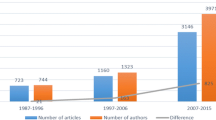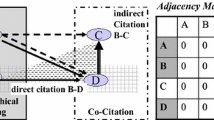Abstract
In this paper, we will study the field through the problematic network built by scientific articles, using actor-network theory (and consequently coword analysis) as a model for scientific knowledge (regarded as a social process) growth. Scientometrics is an hybrid field made of invisible college and a lot of users, thus controlled by both scientific research and final uses. Coword analysis gives the same weight to all articles, cited or not, and consequently computes the interaction network within all kind of authors. According to already described network properties of scientific interaction, coword analysis describes the dynamic of the field in accordance with what has been observed, and suggest forecast for the future.
Similar content being viewed by others
References
Glänzel, Schoepflin, Little Scientometrics, Big Scientometrics... and Beyond, 4th Informetrics, Bibliometrics and Scientometrics Meeting, Berlin, 11–15 Sept 93.
A. Schubert, H. Maczelka, Cognitive changes in scientometrics during the 1980s, as reflected by the reference patterns of its core journal,Social Studies of Science, 23 (1993) 571–581.
P. Wouters, L. Leydesdorff, Has Price's Dream Come True: is Scientometrics a Field of Science?, 4th Informetrics, Bibliometrics and Scientometrics Meeting, Berlin, 11–15 Sept 93.
M. Callon, J. P. Courtial, F. Laville, Coword analysis as a tool for describing the network of interactions between basic and technological research: the case of polymer chemistry,Scientometrics, 22 (1991) 155–205.
F. Cano, S. Julian,Scientometrics, 24 (1992) 43–59.
Some of these networks can also be obtained through citations at the end of the article.
We can also use title words, sometimes more precise words, but what is important in coword analysis is word associations and more particularly word sub-networks. Results are consequently not very different with title words as shown byJ. Whittaker, Creativity and conformity in science: Titles, key-words and coword analysis.Social Studies of Science, 19 (1990) 473–493.
J. P. Courtial, Qualitative models, quantitative tools and network analysis,Scientometrics, 15 (1989) 527–534;J. P. Courtial, T. Cahlik, M. Callon, A model for social interaction between cognition and action through a key-word simulation of knowledge growth,Scientometrics, 31 (1994) 173–192.
M. Callon, J. Law, A. Rip,Mapping the Dynamics of Science and Technology, MacMillan, London, 1986.
R. Burt, Social contagion and innovation, cohesion versus structural equivalence,American Journal of Sociology, 92 (1987) 1287–1335.
In 1992–93, 13 scientific articles in PASCAL database use coword analysis, white only 6 coword analysis articles are in our file.
In the case of citation analysis which was located in a similar way in the first time period, it has been the development of scientific research evaluation that has absorbed the key-word — separating it from journal analysis — puting it in the upper right quadrant. But, in the second time period, there is no more crossroad theme move within the file that could attract coword analysis. Cocitation analysis doesnot appear at all in key-words.
Author information
Authors and Affiliations
Rights and permissions
About this article
Cite this article
Courtial, J.P. A coword analysis of scientometrics. Scientometrics 31, 251–260 (1994). https://doi.org/10.1007/BF02016875
Received:
Issue Date:
DOI: https://doi.org/10.1007/BF02016875




